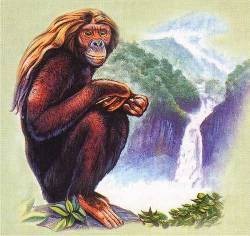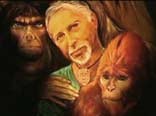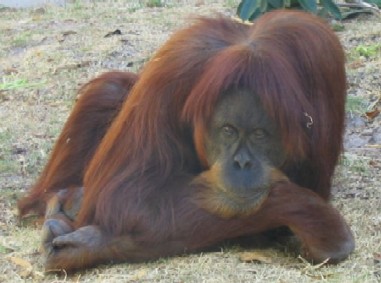
May 19, 2006
Is it true that all hominids are hominoids but not all hominoids are hominids? Where do the pongids and anthropoids fall, as hominoids but not hominids? And what the heck is a homin? Who is on first, anyway?
What are the various definitions of humanoid, hominoid, hominid, hominology, homin, anthropoid, and pongid?

These jumble of words are loosely used when discussing Bigfoot, Sasquatch, Mawas, Almas, Yeti, Yowie, Orang Pendek, and a wide variety of hairy, upright or semi-bipedal humanlike cryptids. (See definition of cryptid here.) Can we sort out some basic definitions and understand some meanings for all of these terms?
Let’s try, with some examples from the way they are being used in the cryptozoology and popular literature.
Humanoid
n: Having human characteristics or form.
adj: A being having human form.
“Bigfoot is described as a large, bipedal hairy humanoid creature living in remote wilderness areas of the United States and Canada.” – Wikipedia.
Hominoid
n: A member of the Hominoidea.
adj: Of or belonging to the superfamily Hominoidea, which includes apes and humans. Resembling a human.
“Thousands of people claim to have seen the hairy hominoid, but the evidence of its existence is fuzzy.” – Stefan Lovgren, National Geographic News
“In an article published in New Scientist, [Dr. Jeff] Meldrum noted that the imprint seems to have been made by a large, hair-covered hominoid more than 2.5 meters tall.” – Loren Coleman, Bigfoot! The True Story of Apes in America
“The drawback of the term ‘hominoid’ for us [the Russian hominologists] is in the fact that in the systematics of primates it embraces both apes (pongids) and hominids (to which our subject belongs).” – Dmitri Bayanov, Crypto: Hominology Special Number I
Hominid
n. A bipedal primate of the family Hominidae, of which Homo sapiens is the only extant species.
adj : characterizing the family Hominidae, which includes Homo sapiens sapiens as well as extinct species of manlike creatures.
“[Ivan T.] Sanderson’s book remains notable as perhaps the first book-length survey of enigmatic ‘hairy hominids’, and certainly helped popularize Yeti, Bigfoot and other mysterious primates, reported worldwide.” – Anon., Wikipedia
“Accordingly, we still do not have any hard evidence that the alleged Thai tua yeua really exists anymore than we do the other hirsute hominids in the Asian Pacific Rim.” – Bobbie Short, Crypto: Hominology Special Number I
Hominology
“Russian researcher Dmitri Bayanov coined the word ‘hominology’ around 1973, to denote those investigations that study humanity’s as yet-undiscovered near-relatives, including Almas, Yeti, Bigfoot/Sasquatch, and other unknown hominoids. He further defined hominology as a ‘branch of primatology, called upon to bridge the gap between zoology and anthropology’ in a 1973 letter to the London primatologist John Napier. His English paper on the subject was a major breakthrough contribution after decades of unpublicized Russian research and expeditions. The paper, ‘A Hominologist View from Moscow, USSR,’ appeared in Northwest Anthropological Research Notes, (Moscow, Idaho), vol. 11, no. 1, 1977.”- Loren Coleman, Cryptozoology A to Z
That is what I wrote in the 1990s. Today, I would modify that to more strictly note that the Russians consider their study of hominids, alone, not of hominoids, because they are not interested, apparently, in any pongids that may get into the mix.
Homin
“Homin” is a term coined by Dmitri Bayanov to be used instead of the words Bigfoot, Sasquatch, Almas, and other local, regional names of unknown, upright, hairy primates. Bayanov defines “homin” as a “non-sapiens hominid.”
The contemporary practice of using “homin” appears to be restricted mostly to Russian hominologists, and their close associates, including North Carolina’s William Duncan, California’s Bobbie Short, and Tennessee’s Mary Alayne Green and Janice Carter Coy. While the Russian term “hominology” has persevered and spread among Bigfoot researchers, in general, “homin” has not.
One reason it is not more popular may be that in the English-speaking world, the word “homin” is visually and lingusitically experienced as truncated, almost a typographical error. Also, for those that understand root words, it is viewed as more related to being from the Latin homin-, stem of Latin homo, meaning “human being,” than the generalized Bigfoot appears to require.
Nevertheless, followers of the Russians, as noted, tend to use “homin” heavily, as reflected, for example, in Will Duncan’s title of his 2002 paper, “The Predictability of Homin Behavior,” and in conjunction with the word “hirsute” (hairy) by Bobbie Short.
“A Registered Nurse by occupation, Bobbie [Short] is an active Bigfoot researcher and field investigator with a growing database of hirsute homin sightings.” – Anon., Crypto: Hominology Special Number I
“Actually, homin-ology can be nothing but the science of homins.” – Dmitri Bayanov, Crypto: Hominology Special Number I
Anthropoid
n. An ape of the family Pongidae. Also called anthropoid ape.
adj.
1. Resembling a human, especially in shape or outward appearance.
2. Of or belonging to the group of great apes of the family Pongidae, which includes the gorilla, chimpanzee, and orangutan.
3. Resembling or characteristic of an ape; apelike.

“Now there is no known ape, even among the anthropoids, which normally walks upright on its hind legs.” – Bernard Heuvelmans, On the Track of Unknown Animals
“In the West they call the Yeti ‘a bipedal anthropoid,’ putting it in the family of apes, despite the fact that apes are quadrupedal.” – Dmitri Bayanov, Crypto: Hominology Special Number I
“Ramona Clark and other researchers from the Sunshine State [Florida] gathered reports in the 1950s-1970s, which described unknown anthropoids, not hominids.” – Loren Coleman, Bigfoot! The True Story of Apes in America
Pongid
A member of the family Pongidae, generally referred to as the “great apes” contains three genuses, Pongo, Gorilla, and Pan, and four species: Pongo pygmaeus (orangutans), Gorilla gorilla (gorillas), Pan troglodytes (chimpanzees), and Pan paniscus (bonobos, also known as pymgy chimpanzees).

n. An anthropoid ape of the family Pongidae, which includes the chimpanzee, gorilla, and orangutan.
adj. Of or belonging to the family Pongidae.
“Our ‘Unknown Pongid’ class combines the more ‘bestial’ members of [Ivan T.] Sanderson’s Sub-Hominids type with members of [Mark A.] Hall’s Yeti group, a name which we feel is too closely linked to creatures of the Himalayas.” – Loren Coleman & Patrick Huyghe, The Field Guide of Bigfoot and Other Mystery Primates
“Today, the majority of anthropologists believe Gigantopithecus was pongid and not hominid.” – Jeff Glickman, “Toward a Resolution of the Bigfoot Phenomenon”
Conclusion
So, bottomline, is Bigfoot a hominid, a hominoid or a homin? A hominid or a pongid? Are Skunk Apes, anthropoids?
Of course, we don’t know yet, until DNA testing results are finalized. But today, most hominologists declare they are more comfortable that their research shows the classic Bigfoot/Sasquatch of the Pacific Northwest is more hominid than pongid. Thus, the Russians feel justified in calling them homins. But what of the more routinely quadrupedal, the Skunk Apes of Florida, or even some forms of Yeti? For the apelike forms of the so-called Abominable Snowmen of the Himalayas or some types of the Johor Mawas, these cryptids may be more pongid, especially if the discovered animals are found to have affinities to Gigantopithecus or to modern apes. This case is clearest with the Bili Apes, who are being realized as firmly cryptid pongids, especially if the recent DNA findings saying they are a subspecies of chimpanzee are fully confirmed.
But as long as our Russian colleagues wish to define “homins” as strictly “hominids,” and “hominology” as only within the parameters of the study of homins, we have to ask, are the unknown pongids orphans among hominologists? And what if Bigfoot is found to be the first-ever bipedal pongid?
Perhaps, the safest answer for all unknown hairy primates that mirror the appearance of humans and apes may be to continue to call them unknown “hominoids.” Needless to say, they all remain cryptids that request the attention of cryptozoologists, even if some hominologists decide to reject them because they (the cryptid primates) are not hominid enough.
Thanks to Doug Tarrant for asking the question to begin this linguistic exploration.
About Loren Coleman
Loren Coleman is one of the world’s leading cryptozoologists, some say “the” leading living cryptozoologist. Certainly, he is acknowledged as the current living American researcher and writer who has most popularized cryptozoology in the late 20th and early 21st centuries.
Starting his fieldwork and investigations in 1960, after traveling and trekking extensively in pursuit of cryptozoological mysteries, Coleman began writing to share his experiences in 1969. An honorary member of Ivan T. Sanderson’s Society for the Investigation of the Unexplained in the 1970s, Coleman has been bestowed with similar honorary memberships of the North Idaho College Cryptozoology Club in 1983, and in subsequent years, that of the British Columbia Scientific Cryptozoology Club, CryptoSafari International, and other international organizations. He was also a Life Member and Benefactor of the International Society of Cryptozoology (now-defunct).
Loren Coleman’s daily blog, as a member of the Cryptomundo Team, served as an ongoing avenue of communication for the ever-growing body of cryptozoo news from 2005 through 2013. He returned as an infrequent contributor beginning Halloween week of 2015.
Coleman is the founder in 2003, and current director of the International Cryptozoology Museum in Portland, Maine.
Filed under Abominable Snowman, Almas, Bigfoot, Books, Breaking News, CryptoZoo News, Cryptozoology, Malaysian Bigfoot, Skunk Apes, Yeti, Yowie